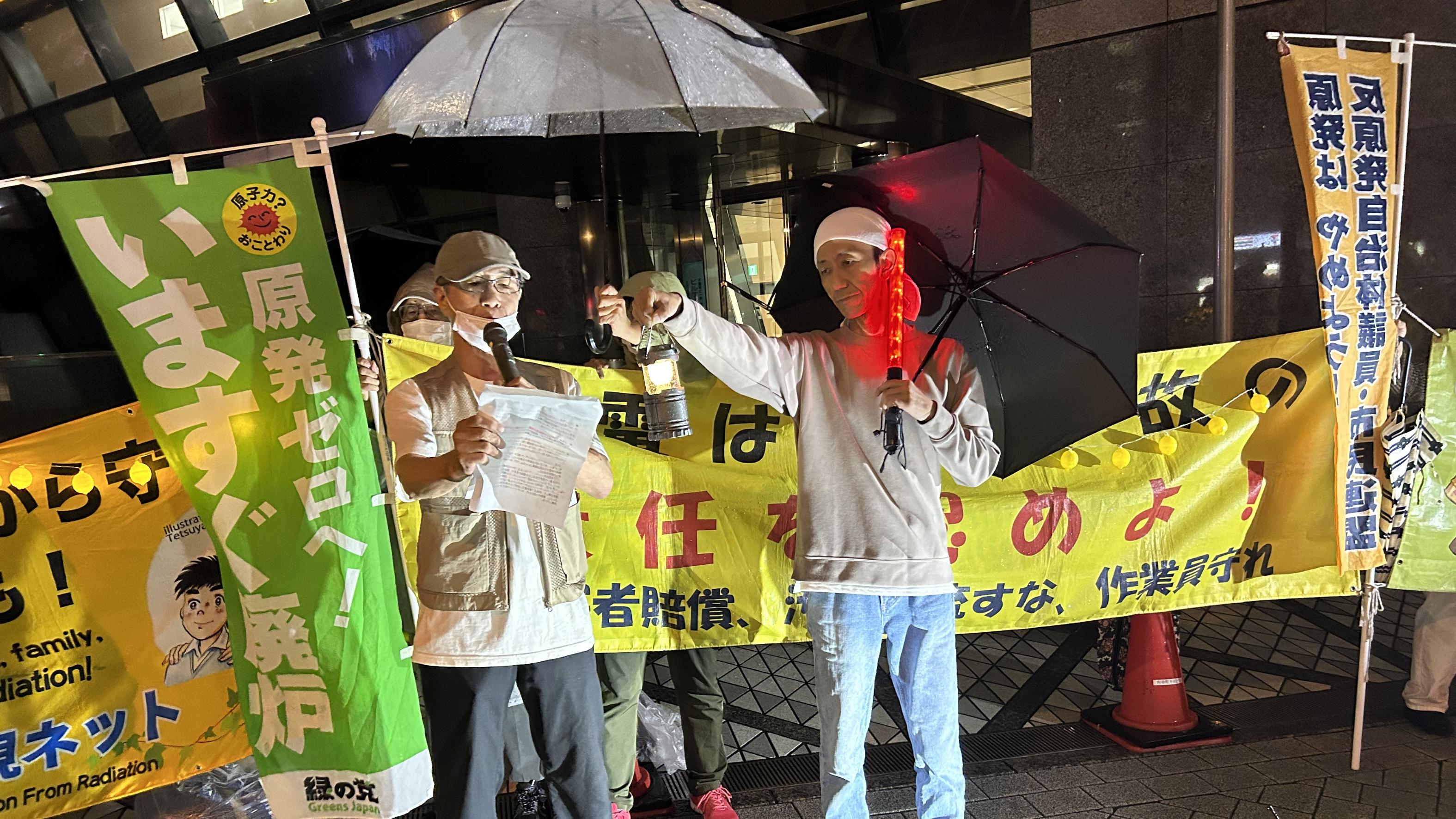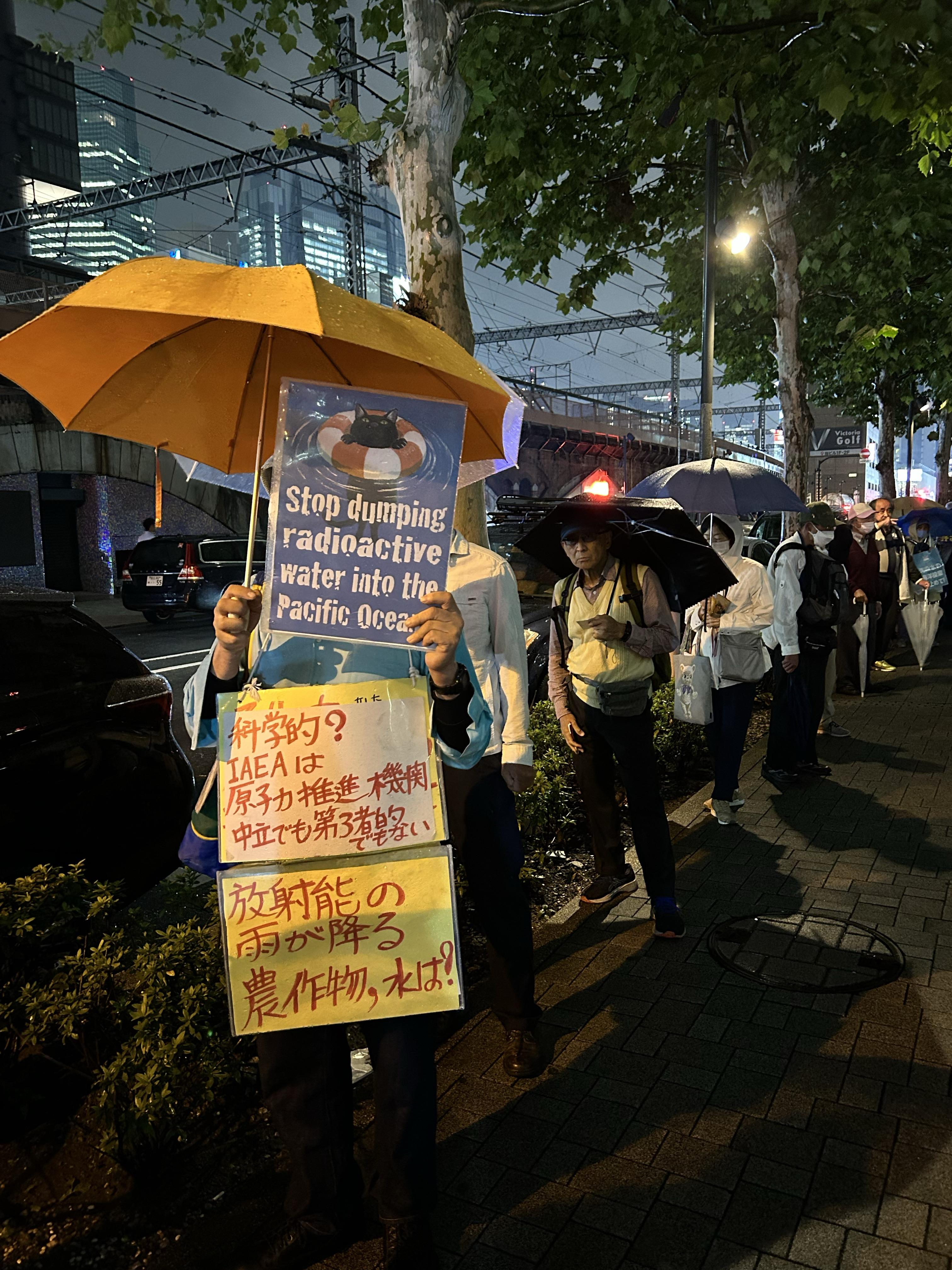 Japanese protesters rally in front of the head office of TEPCO in Tokyo on Oct 4 despite the rain, urging the company to stop releasing radioactively contaminated water into the sea. (JIANG XUEQING / CHINA DAILY)
Japanese protesters rally in front of the head office of TEPCO in Tokyo on Oct 4 despite the rain, urging the company to stop releasing radioactively contaminated water into the sea. (JIANG XUEQING / CHINA DAILY)
Japanese people called for an immediate halt to the release of radioactively contaminated water from the crippled Fukushima Daiichi nuclear power plant into the Pacific Ocean but the Tokyo Electric Power Company (TEPCO) insisted on launching the second round of discharge on Oct 5.
The discharge commenced at around 10:30 am local time despite opposition from fishermen and residents of Japan. TEPCO, the plant’s operator, said it plans to release 7,800 metric tons of the radioactive wastewater over 17 days, roughly the same amount as the first discharge.
“The Japanese government and TEPCO should immediately cease ocean discharge and seriously consider alternative options. Alternatives such as mortar solidification are indeed viable,” said Kenichi Oshima, a policy science professor at Ryukoku University and chairperson of the Citizens’ Commission on Nuclear Energy, in a written interview with China Daily.
READ MORE: Fukushima: Mothers' group voices concerns on wastewater release
Groups of Japanese people held a rally in front of the head office of TEPCO in Tokyo late on Oct 4 despite the rain, urging the company to stop releasing radioactively contaminated water into the sea.
 Japanese protesters rally in front of the head office of TEPCO in Tokyo on Oct 4 despite the rain, urging the company to stop releasing radioactively contaminated water into the sea. (JIANG XUEQING / CHINA DAILY)
Japanese protesters rally in front of the head office of TEPCO in Tokyo on Oct 4 despite the rain, urging the company to stop releasing radioactively contaminated water into the sea. (JIANG XUEQING / CHINA DAILY)
“Disposing of water that has come into contact with melted fuel, which was never anticipated, goes against various methods and there is no way to prove its safety,” said Hisataka Yamasaki, a board member of the non-governmental organization No Nukes Plaza Tokyo, also known as Tanpoposya.
TEPCO has not measured over 60 types of nuclides present in contaminated water. The company claimed it can measure these nuclides using specific indicators or through proportional calculations, but this has not been scientifically proven, Yamasaki said.
He criticized TEPCO and the Japanese government for only focusing on forcing their predetermined ocean discharge method, essentially pushing it onto people.
“There’s a severe lack of the thorough process of listening to various opinions and making decisions in this country,” he said.
Motoo Tomizuka, a member of No Nukes Plaza Japan, said: “Various health problems have occurred due to the radiation from Fukushima, and the number of affected people is increasing. The Japanese government is doing something terrible. It’s outrageous.”
Many participants of the rally said TEPCO should store the contaminated water in tanks as a first step and then consider a method like cement mortar solidification as a second step.
During his speech at the rally, Toshihiko Sasaki, a 72-year-old resident of Chiba City, quoted a position paper published by the US National Association of Marine Laboratories, or NAML, in December 2022. The NAML, an organization of more than 100 member laboratories, opposed the release of the over 1.3 million metric tons of radioactively contaminated water into the ocean.
“The supporting data provided by TEPCO and the Japanese government are insufficient and, in some cases, incorrect, with flaws in sampling protocols, statistical design, sample analyses, and assumptions, which in turn lead to flaws in the conclusion of safety and prevent a more thorough evaluation of better alternative approaches to disposal,” the NAML said.
 Japanese protesters rally in front of the head office of TEPCO in Tokyo on Oct 4 despite the rain, urging the company to stop releasing radioactively contaminated water into the sea. (JIANG XUEQING / CHINA DAILY)
Japanese protesters rally in front of the head office of TEPCO in Tokyo on Oct 4 despite the rain, urging the company to stop releasing radioactively contaminated water into the sea. (JIANG XUEQING / CHINA DAILY)
Umeko Mochizuki, a 74-year-old participant of the rally on Oct 4, said: “We don’t really know what the impact of the discharge of contaminated water into the ocean will be. It’s not something that will show up in a year, and we don’t even know how many years it will take. That’s why I think the best course of action is to stop the release of radioactively contaminated water immediately, rather than trying to provide reassurance.”
It is said that contaminated water flowing from the Fukushima plant contains more than 60 types of radionuclides, and there are radionuclides that the Advanced Liquid Processing System cannot completely remove, said Takae Miyaguchi, a 73-year-old Tokyo resident.
READ MORE: Fukushima water: Japan urged to rethink its plan as concerns mount
She called on TEPCO to disclose thoroughly transparent information about its discharge of contaminated water and urged the Japanese government to conduct assessments on the long-term impact of the discharge.
Contact the writer at jiangxueqing@chinadaily.com.cn


